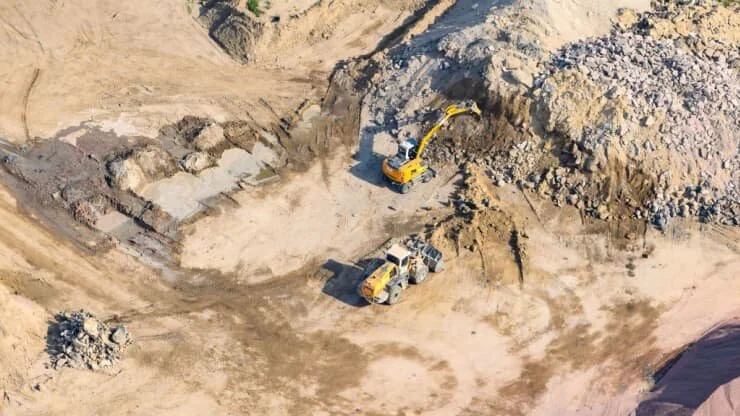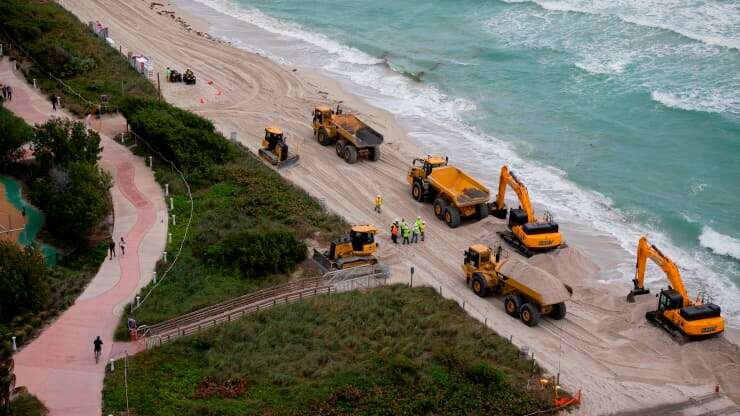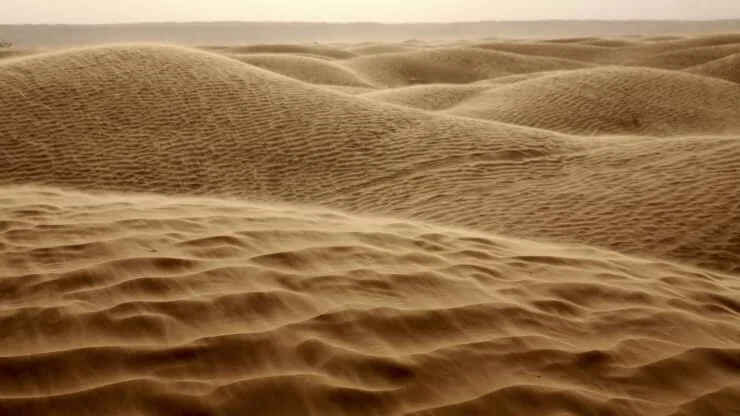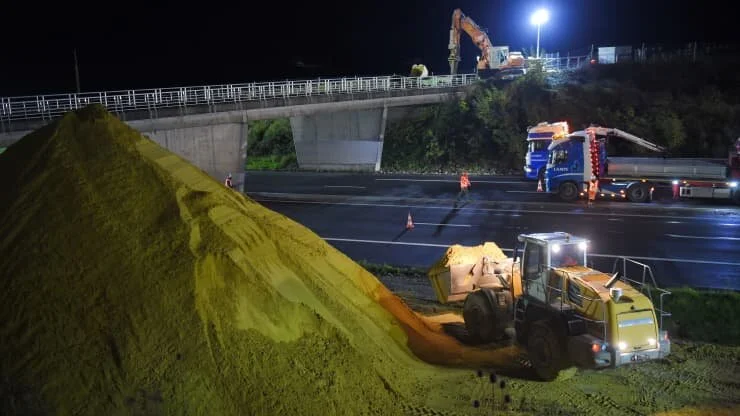Sand is the world’s most consumed raw material after water and an essential ingredient to our everyday lives.
Yet, the world is facing a shortage — and climate scientists say it constitutes one of the greatest sustainability challenges of the 21st century.
“Is it time for panicking? Well, that will certainly not help, but it is time to take a look and change our perception about sand,” said Pascal Peduzzi, a climate scientist with the United Nations Environment Programme.
Dozens of trucks dump hundreds of thousands of tons of sand on Miami Beach as part of U.S. government measures to protect Florida’s tourist destinations against the effects of climate change.
EVA MARIE UZCATEGUI | AFP | Getty Images
LONDON — An insatiable global appetite for sand, one of the world’s most important but least appreciated commodities, is unlikely to let up anytime soon. The problem, however, is that this resource is slipping away.
Our entire society is built on sand. It is the world’s most consumed raw material after water and an essential ingredient to our everyday lives.
Sand is the primary substance used in the construction of roads, bridges, high-speed trains and even land regeneration projects. Sand, gravel and rock crushed together are melted down to make the glass used in every window, computer screen and smart phone. Even the production of silicon chips uses sand.
Yet, the world is facing a shortage — and climate scientists say it constitutes one of the greatest sustainability challenges of the 21st century.
“Is it time for panicking? Well, that will certainly not help, but it is time to take a look and change our perception about sand,” Pascal Peduzzi, a climate scientist with the United Nations Environment Programme, said during a webinar hosted by think tank Chatham House.
“
We never thought we would run out of sand, but it is starting in some places.”
Peduzzi, who is the director of UNEP’s Global Resource Information Database in Geneva, Switzerland, described the global governance of sand resources as “the elephant in the room.”
“We just think that sand is everywhere. We never thought we would run out of sand, but it is starting in some places. It is about anticipating what can happen in the next decade or so because if we don’t look forward, if we don’t anticipate, we will have massive problems about sand supply but also about land planning,” he added.
A sand-fueled construction boom
Sand dunes in the Sahara desert.
Getty Images
At present, it is not possible to accurately monitor global sand use. However, Peduzzi said it could be measured indirectly, citing a “very, very good” correlation between the use of sand and cement.
The UN estimates that 4.1 billion tons of cement is produced every year, driven primarily by China, which constitutes 58% of today’s sand-fueled construction boom.
The global use of sand and gravels has been found to be 10 times higher than that of cement. This means that, for construction alone, the world consumes roughly 40 to 50 billion tons of sand on an annual basis. That’s enough to build a wall of 27 meters high by 27 meters wide that wraps around the planet every year.
The global rate of sand use — which has tripled over the last two decades partially as a result of surging urbanization — far exceeds the natural rate at which sand is being replenished by the weathering of rocks by wind and water.
Sand can be found on almost every country on Earth, blanketing deserts and lining coastlines around the world. But that is not to say that all sand is useful. Desert sand grains, eroded by the wind rather than water, is too smooth and rounded to bind together for construction purposes.
The sand that is highly sought after is more angular and can lock together. It is typically sourced and extracted from seabeds, coastlines, quarries and rivers around the world.
‘A grain of change’
Construction cranes and vehicles cover the A10 highway between Paris and Bordeaux with sand on November 6, 2019 near Monts, central France.
GUILLAUME SOUVANT | AFP | Getty Images
Louise Gallagher, environmental governance lead at the UNEP/GRID-Geneva’s Global Sand Observatory Initiative, said the issues around sand had become a “diffuse” and “complex” problem to resolve.
For instance, she said the banning of river sand extraction would inevitably have a knock-on effect for the people and communities who rely on this practice to earn a living.
China and India top the list of areas where sand extraction impacts on rivers, lakes and on coastlines, largely as a result of soaring infrastructure and construction demand.
UNEP has previously warned of thriving “sand mafias,” with groups comprising of builders, dealers and businessmen known to be operating in countries such as Cambodia, Vietnam, Kenya and Sierra Leone. Activists working to shine a light on their activities, UNEP said, are being threatened and even killed.
Sand is “perceived as cheap, available and infinite and that is partly because the environmental and social costs are pretty much not priced in,” Gallagher said on Tuesday during the same webinar.
“It seems like we believe the highest use value for this material right now is to extract it from the natural environment rather than keeping it in the system for the other types of benefits we get from it like say, for example, climate resilience in coastal areas,” she continued.
“We need to think about putting a little order on the chaos of that crazy fragmented picture — and that’s happening. That’s the good news. We are not ignoring, I think, this problem any further. It is not as invisible as it used to be.”
Gallagher identified five priorities for sand resource governance over the next two years: cooperation on global standards across all sectors, cost-effective and viable alternatives to river and marine sand, updating environmental, social and corporate governance frameworks in the financial sector to include sand, bringing in ground-level voices and setting regional, national and global goals on sand use at the right scale.
‘No-one is even talking about this issue’
“I’d say a grain of sand can be a grain of change,” said Kiran Pereira, researcher and founder of SandStories.org.
An excavator and a bulldozer are working on the grounds of the gravel plant and the concrete mixing plant of the Max Bögl group of companies.
Soeren Stache | picture alliance | Getty Images
“It is important to focus on good things that are happening. Zurich, for example, is building buildings with 98% recycled concrete. The city of Amsterdam has committed to becoming 100% circular by 2050 (and) they aim to halve their natural resource use by 2030. That is the way to go,” Pereira said.
The wake-up call on the global sand shortage, Peduzzi said, came in 2019 when governments recognized the environmental crisis for the first time and the issue was finally placed on the political agenda as a result of a UN resolution.
Unfortunately, Peduzzi told CNBC that the challenge has still not been adequately addressed on the global stage.
“It is still very much new. In many of the development policies, there is no-one even talking about this issue of sand, where it is coming from, the social impacts or the environmental impacts, so there is a lot of things to be done,” he continued.
“Yet, no big plans, no standard on how it should be extracted, no land planning on where you should extract and where you should not extract, no monitoring to where it is coming from in most of the places (and) no enforcement of laws because countries are pondering between development needs and the protection of the environment.”
Looking ahead, industrialization, population growth and urbanization are all trends likely to fuel explosive growth in the demand for sand.
“It’s time to wake up,” Peduzzi said.





